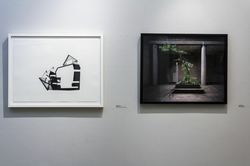| « Studio Gang to Design UC Dorm/Dining Complex | Inspiring Beauty: 50 Years of Ebony Fashion Fair at the Chicago History Museum » |
Art Wed Jul 31 2013
Curated Structured Conversations
Up at the Noyes Cultural Arts Center right now is a two person show that I would consider pretty exciting and a must see--not just because of the two artists it brings together but because they were brought together by Susan A. Gescheidle. For those of you that don't know, Gescheidle ran a gallery in the West Loop which closed in 2008. In my opinion, she helped support and shepherd contemporary conceptual art into Chicago, and to be able to see her hand so clearly in this show is a great treat.
In this show, aptly entitled "Structured Conversations," Gescheidle brings together Nate Mathews and Rafael E. Vera. Vera, who is represented at Bert Green Fine Arts , has large graphite on paper pieces of concrete blocks or walls that either wall us in or out. He also has a couple of drawings combined with silkscreens to create more dramatic visual effects while breaking away from the fencing in. Mathews is a photographer who, from what I can tell, has a keen eye for spaces that have been designed to enjoy, in one way or another, but have gone into disuse. The idea here, I think, is that we build lobbies or areas to accommodate moving and/or resting people; however, there was a time, before urban planners became a dime a dozen, that we didn't think holistically enough at the problem of needing or noticing that space. This led us to have an abundance of areas where no one seems to notice. These spaces are the focus of Mathews' photographs.
 When we put these two artists together, it can seem a good enough fit to have a solid show worth mentioning, but it is not until we notice the curator's hand in the hanging that this show becomes a real eye catcher. I have to say I am not one to boast about curation unless there is a real good reason to do so, and this show is a real good reason. Gescheidle hung these two artists in groups, consisting of two and three pieces in each grouping. There are groups that focus on space, size, solidity of form and placement and how odd, eerie, and surprising the spaces being presented actually are. It was easy for me to look at each piece, but it was not until I stood back to take in the groupings that the show and its message came across. In her curatorial notes, Gescheidle mentioned, perhaps offhandedly, that "the devil is in the details." That really wraps up some of the experiences one might have viewing this show.
When we put these two artists together, it can seem a good enough fit to have a solid show worth mentioning, but it is not until we notice the curator's hand in the hanging that this show becomes a real eye catcher. I have to say I am not one to boast about curation unless there is a real good reason to do so, and this show is a real good reason. Gescheidle hung these two artists in groups, consisting of two and three pieces in each grouping. There are groups that focus on space, size, solidity of form and placement and how odd, eerie, and surprising the spaces being presented actually are. It was easy for me to look at each piece, but it was not until I stood back to take in the groupings that the show and its message came across. In her curatorial notes, Gescheidle mentioned, perhaps offhandedly, that "the devil is in the details." That really wraps up some of the experiences one might have viewing this show.









